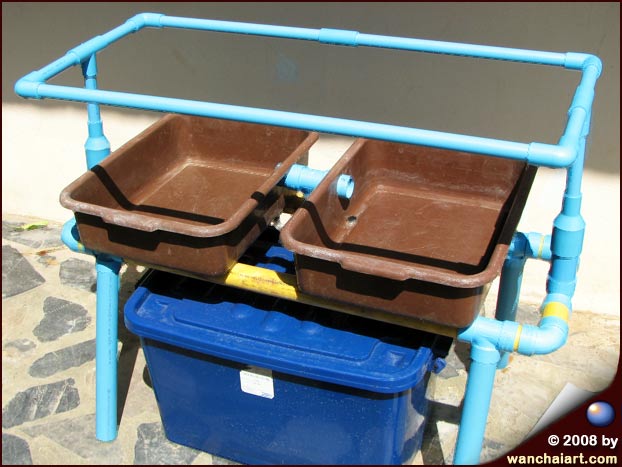First of all, an update of the setup with finished support extension. Well, the whole setup will probably not win any beauty contest so far, but with a little paint spraying (to uniform and neutralize the look), - it's kinda acceptable, I guess

Not a single screw, not a drip of silicone or sealer, no special parts. If I'd acquire all parts new, it would only cost me around (reservoir,
pump and media included) some 28, or let's say 30 USD.

BTW: the depth is almost exactly 5 inches.
Quote:
Originally Posted by GpsFrontier

I am not familiar with growing corn yet, but I to would think a drip system would be the most economical system due to the root space required and changing of nutrients, compared to flooding the whole system. |
I am not understanding what could possibly be the issue with "flooding the whole system"? With E/F, flooding does the trick.
Actually I am mainly using drip systems with different sizes of pots and buckets and hence agree with the fact of it being a good working and so to speak economical system for many plants and uses. I'll probably give it a shot in one or two buckets as well. But then again, personally I wouldn't build- or mainly use a bucket based drip and recycle system for corn. Also, what I have shown here is rather meant to be a "testing station". If growing corn hydroponically in a bigger scale, I'd even go for a
very different setup (based on E/F or drip and waste). If there is interest in these, just ask....
Still, every system has it's pros and cons. A E/F system uses only
1 rather big and flat growing container. Fed by simple E/F only, it is still the most simple, reliability- and tech-wise the most economical there is. No "expensive" dripers, no complex inline or outline tubes, no long distances from reservoir to buckets to cover, no clogging either. And most importantly, only a single (or double as in my design) growing container that can actually hold more plants per square foot as a few buckets occupying the same space. I am not talking of rather fancy looking varieties of this application, but about the classical setup as described. All varieties mostly use a lot of tubing, multiple growing containers and other special features which aren't bringing any real advantage - at least as far as I can see or tell....
Of course, any non-ergonomically designed E/F system could end up in a "waste" of space, media, energy and resources as well.
In any discussion, exchange of mindsets, opinions, - there always is a huge part of subjectivity hat comes from personal likes vs. dislikes and choices which are often based on
personal observations and conclusions. We are individuals, and there are particular conditions involved as well. We shouldn't forget about that at no time and have a neutral and proper view on these aspects of communication and exchange of informations. While individuals tend to defend "their very personal preferences", - the silent and unforgivable logic of functionality and non-negotiable economics do always lurk and smile knowingly...in the background

About the other questions: Corn is a field crop and (even if fast growing) not very demanding in
nutrient requirements. The formula I gave earlier has nothing very fancy and could be used with many other plants that are not considered as leafy vegetables. I don't actually fall for numerous PH-charts found at many places of the web, either for plants in general, or typically for hydroponics. Because in soil-less culture, the ideal uptake ratio vs. PH is very limited. The best range for uptake of all elements is between 5.9 and 6.5 Outside that range uptake of certain elements isn't optimal. And any plant that doesn't fall into that range (
for real), can be considered "difficult to grow in hydroponics" anyway.
Keep your PH between 6 and 6.5 (in most cases closer to 6) and all plants are growing very fine. There is nothing more to do, to know or to narrate about...
OR, do your own experiments, research and tests and watch and learn from the results. And at the end, consider it as what applies to the nutrients, the media and the respective setup that is used. And consider your local climate and all around conditions as well. Last but not least, any outcome or result that isn't backed up by a control group or other elementary scientific basics, has to be considered as, what skeptics like me call - a
selective observation only
